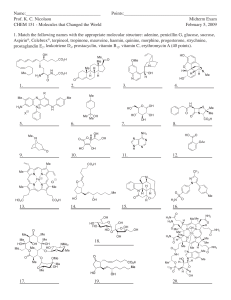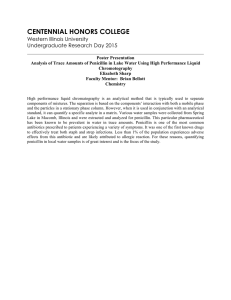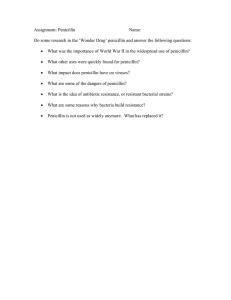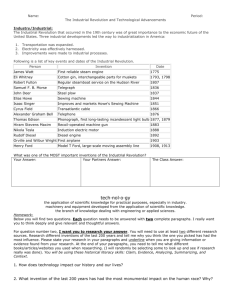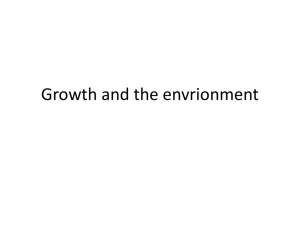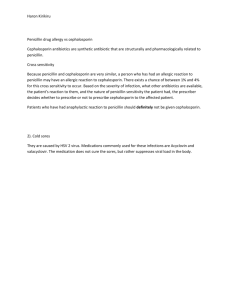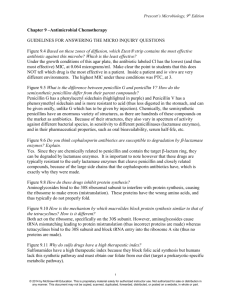Prof. K. C. nicolaou Midterm Exam february 5, 2009
advertisement
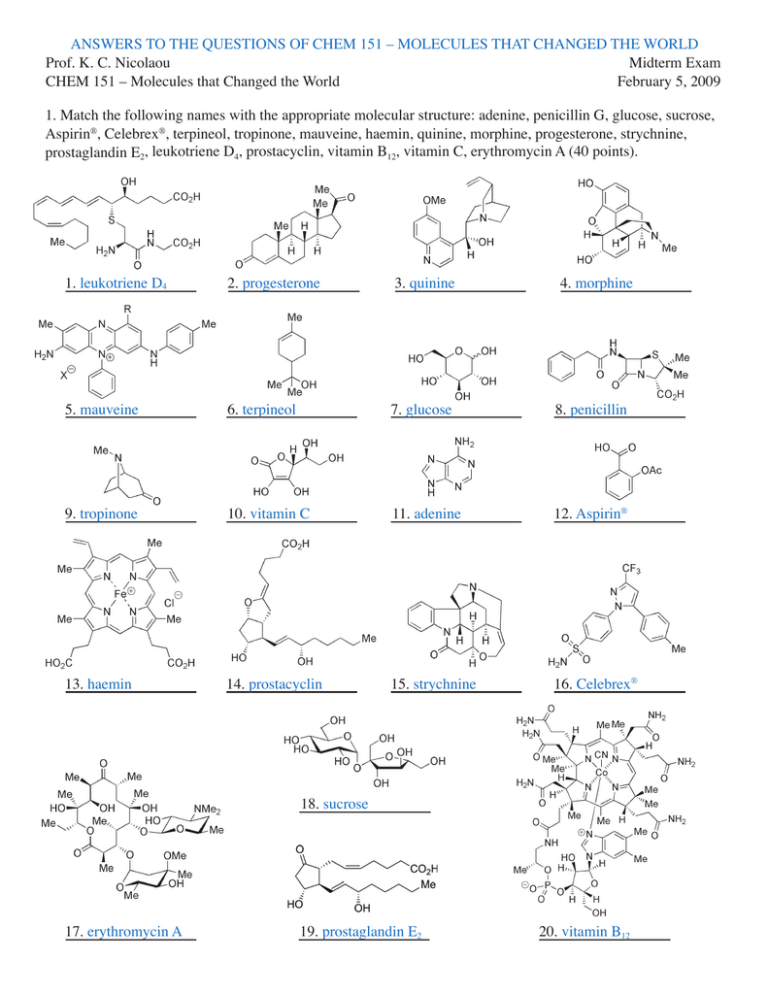
Answers to the Questions of CHEM 151 – Molecules that Changed the World Prof. K. C. Nicolaou Midterm Exam CHEM 151 – Molecules that Changed the WorldFebruary 5, 2009 1. Match the following names with the appropriate molecular structure: adenine, penicillin G, glucose, sucrose, Aspirin®, Celebrex®, terpineol, tropinone, mauveine, haemin, quinine, morphine, progesterone, strychnine, prostaglandin E2, leukotriene D4, prostacyclin, vitamin B12, vitamin C, erythromycin A (40 points). 1. leukotriene D4 2. progesterone 3. quinine 4. morphine 5. mauveine 6. terpineol 7. glucose 8. penicillin 9. tropinone 10. vitamin C 11. adenine 12. Aspirin® 13. haemin 14. prostacyclin 15. strychnine 16. Celebrex® 18. sucrose 17. erythromycin A 19. prostaglandin E2 20. vitamin B12 2. Match the following names with the appropriate discovery, achievement or theory shown below: Demokritos, Friedrich Wöhler, R. B. Woodward, E. J. Corey, Emil Fischer, John C. Sheehan, Sir Robert Robinson, William Henry Perkin, Sr., Alexander Fleming, Dorothy Crowfoot Hodgkin (20 points). 1. The discovery of the purple dye mauviene: William Henry Perkin, Sr. 2. The first total synthesis of glucose: Emil Fischer 3. The first total synthesis of urea: Friedrich Wöhler 4. The first total synthesis of penicillin G: John C. Sheehan 5. The Atomic Theory of matter: Demokritos 6. The concept of Retrosynthetic Analysis: E. J. Corey 7. The introduction of the arrow to describe reaction mechanisms: Sr. Robert Robinson 8. The discovery of penicillin: Alexander Fleming 9. The x-ray crystallographic analysis of penicillin and vitamin B12: Dorothy Crowfoot Hodgkin 10. The first synthesis of quinine and strychnine: R. B. Woodward 3. Match each of the following molecules with their use, biological activity or medical indication: penicillin, morphine, haemin, quinine, prostacyclin, thromboxane, Aspirin®, monensin, chlorophyll, leukotriene D4 (20 points). D4 1. leukotriene ______________________ Causes constrictions in the lungs, involved in asthmatic attacks. 2. haemin ______________________ Responsible for carrying oxygen from the lungs to the cells. 3. chlorophyll ______________________ Involved in photosynthesis in plants. 4. monensin ______________________ Binds metal ions, serves as an antibiotic in agriculture. 5. prostacyclin ______________________ Dilates blood vessels and prevents thrombosis. A2 6. thromboxane ______________________ Constricts blood vessels and causes aggregation of platelets. Aspirin® 7. ______________________ Mild analgesic, pain killer, anti-inflammatory. quinine 8. ______________________ First medication against malaria. penicillin 9. ______________________ First major antibiotic to treat bacterial infections. morphine 10. _____________________ Powerful pain killer, hallucinogenic, narcotic. 4. Name 10 Nobel Prize winners in Chemistry, or in Physiology or Medicine, and describe in one sentence (20 words or less) the contribution for which they were awarded the prize (20 points). Year 1902 Laureate Citation Emil Fischer“in recognition of the extraordinary services he has rendered by his work on sugar and purine syntheses” 1930Hans Fischer“for his researches into the constitution of haemin and chlorophyll and especially for his synthesis of haemin” 1947Sir Robert Robinson“for his investigations on plant products of biological importance, especially the alkaloids” 1950Otto Diels and Kurt Alder “for their discovery and development of the diene synthesis” 1964 Dorothy Crowfoot Hodgkin“for her determinations by X-ray techniques of the structures of important biochemical substances” 1965Robert B. Woodward “for his outstanding achievements in the art of organic synthesis” 1982 Bengt I. Samuelsson“for their discoveries concerning prostaglandins and related biologically active substances” 1990 Elias J. Corey“for his development of the theory and methodology of organic synthesis” 2008 Roger Y. Tsien “for the discovery and development of the green fluorescent protein, GFP” 5. Write a short essay (150 words or less) on the discovery and impact of penicillin on medicine and society, mentioning its discoverers, structural features, synthesis, mechanism of action and medical indications (20 points). Penicillin was discovered and developed by Fleming, Flory, and Chain, for which they won the Nobel Prize in Physiology or Medicine in 1945. It is the first major antibiotic to be discovered from nature. The penicillin molecule contains a b-lactam ring (4-membered) and works by inhibiting the biosynthesis of the bacterial cell wall. Its molecular structure was unambiguously confirmed by x-ray crystallographic analysis carried out by Dorothy Crowfoot Hodgkins in 1945, one year after General Dwight D. Eisenhower carried with him 3 millions dose of penicillin in anticipation of D-Day. Penicillin was synthesized in the laboratory for the first time by John Sheehan’s group in 1957. Penicillin and its derivatives are used to treat bacterial infections. The discovery of penicillin had a major impact on science and medicine and benefited society enormously by saving lives and also inspiring the discovery of countless other biologically active natural products from microbial sources.
